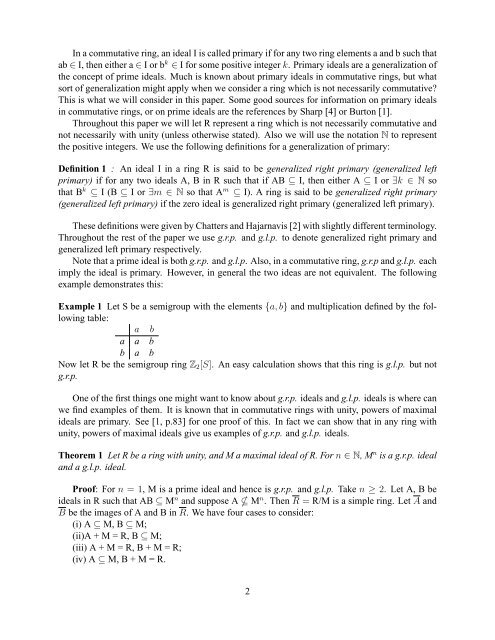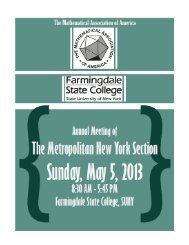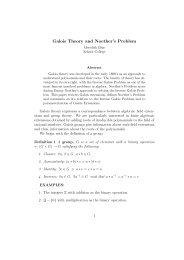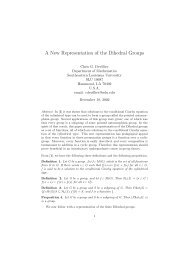Generalizations of Primary Ideals - MAA Sections
Generalizations of Primary Ideals - MAA Sections
Generalizations of Primary Ideals - MAA Sections
You also want an ePaper? Increase the reach of your titles
YUMPU automatically turns print PDFs into web optimized ePapers that Google loves.
In a commutative ring, an ideal I is called primary if for any two ring elements a and b such thatab ∈ I, then either a ∈ I or b k ∈ I for some positive integer k. <strong>Primary</strong> ideals are a generalization <strong>of</strong>the concept <strong>of</strong> prime ideals. Much is known about primary ideals in commutative rings, but whatsort <strong>of</strong> generalization might apply when we consider a ring which is not necessarily commutative?This is what we will consider in this paper. Some good sources for information on primary idealsin commutative rings, or on prime ideals are the references by Sharp [4] or Burton [1].Throughout this paper we will let R represent a ring which is not necessarily commutative andnot necessarily with unity (unless otherwise stated). Also we will use the notation N to representthe positive integers. We use the following definitions for a generalization <strong>of</strong> primary:Definition 1 : An ideal I in a ring R is said to be generalized right primary (generalized leftprimary) if for any two ideals A, B in R such that if AB ⊆ I, then either A ⊆ I or ∃k ∈ N sothat B k ⊆ I (B ⊆ I or ∃m ∈ N so that A m ⊆ I). A ring is said to be generalized right primary(generalized left primary) if the zero ideal is generalized right primary (generalized left primary).These definitions were given by Chatters and Hajarnavis [2] with slightly different terminology.Throughout the rest <strong>of</strong> the paper we use g.r.p. and g.l.p. to denote generalized right primary andgeneralized left primary respectively.Note that a prime ideal is both g.r.p. and g.l.p. Also, in a commutative ring, g.r.p and g.l.p. eachimply the ideal is primary. However, in general the two ideas are not equivalent. The followingexample demonstrates this:Example 1 Let S be a semigroup with the elements {a, b} and multiplication defined by the followingtable:a ba a bb a bNow let R be the semigroup ring Z 2 [S]. An easy calculation shows that this ring is g.l.p. but notg.r.p.One <strong>of</strong> the first things one might want to know about g.r.p. ideals and g.l.p. ideals is where canwe find examples <strong>of</strong> them. It is known that in commutative rings with unity, powers <strong>of</strong> maximalideals are primary. See [1, p.83] for one pro<strong>of</strong> <strong>of</strong> this. In fact we can show that in any ring withunity, powers <strong>of</strong> maximal ideals give us examples <strong>of</strong> g.r.p. and g.l.p. ideals.Theorem 1 Let R be a ring with unity, and M a maximal ideal <strong>of</strong> R. For n ∈ N, M n is a g.r.p. idealand a g.l.p. ideal.Pro<strong>of</strong>: For n = 1, M is a prime ideal and hence is g.r.p. and g.l.p. Take n ≥ 2. Let A, B beideals in R such that AB ⊆ M n and suppose A M n . Then R = R/M is a simple ring. Let A andB be the images <strong>of</strong> A and B in R. We have four cases to consider:(i) A ⊆ M, B ⊆ M;(ii)A + M = R, B ⊆ M;(iii) A + M = R, B + M = R;(iv) A ⊆ M, B + M = R.2
















